Contemporary Accounting Issues: A Strategic Report on Woodside
VerifiedAdded on 2023/06/14
|10
|2513
|121
Report
AI Summary
This report provides an analysis of Woodside Petroleum's strategic management practices within the context of contemporary accounting issues. It begins with an overview of the company, highlighting its position as a major player in the Australian oil and gas industry. The report then delves into the company's strategic management practices, focusing on enhancing core resources, increasing capabilities, and developing its portfolio. Various strategic management theories, including the framework of strategic management, leadership style theory, and resource-based view, are discussed and compared with Woodside Petroleum's actual practices. The analysis reveals that Woodside Petroleum effectively uses a systematic approach aligned with organizational goals, leveraging key values like integrity and sustainability. The company's transformational leadership style, resource-based view, and investments in innovative technologies contribute to its competitive advantage. The report concludes by recommending that Woodside Petroleum consider political and legal interventions to avoid future complications and maintain a good market reputation through effective control frameworks.

qwertyuiopasdfghjklzxcvbnmqw
ertyuiopasdfghjklzxcvbnmqwert
yuiopasdfghjklzxcvbnmqwertyui
opasdfghjklzxcvbnmqwertyuiopa
sdfghjklzxcvbnmqwertyuiopasdf
ghjklzxcvbnmqwertyuiopasdfghj
klzxcvbnmqwertyuiopasdfghjklz
xcvbnmqwertyuiopasdfghjklzxcv
bnmqwertyuiopasdfghjklzxcvbn
mqwertyuiopasdfghjklzxcvbnmq
wertyuiopasdfghjklzxcvbnmqwer
tyuiopasdfghjklzxcvbnmqwertyui
opasdfghjklzxcvbnmqwertyuiopa
sdfghjklzxcvbnmqwertyuiopasdf
ghjklzxcvbnmqwertyuiopasdfghj
klzxcvbnmqwertyuiopasdfghjklz
xcvbnmrtyuiopasdfghjklzxcvbnm
qwertyuiopasdfghjklzxcvbnmqw
CONTEMPORARY ISSUES IN
ACCOUNTING
ertyuiopasdfghjklzxcvbnmqwert
yuiopasdfghjklzxcvbnmqwertyui
opasdfghjklzxcvbnmqwertyuiopa
sdfghjklzxcvbnmqwertyuiopasdf
ghjklzxcvbnmqwertyuiopasdfghj
klzxcvbnmqwertyuiopasdfghjklz
xcvbnmqwertyuiopasdfghjklzxcv
bnmqwertyuiopasdfghjklzxcvbn
mqwertyuiopasdfghjklzxcvbnmq
wertyuiopasdfghjklzxcvbnmqwer
tyuiopasdfghjklzxcvbnmqwertyui
opasdfghjklzxcvbnmqwertyuiopa
sdfghjklzxcvbnmqwertyuiopasdf
ghjklzxcvbnmqwertyuiopasdfghj
klzxcvbnmqwertyuiopasdfghjklz
xcvbnmrtyuiopasdfghjklzxcvbnm
qwertyuiopasdfghjklzxcvbnmqw
CONTEMPORARY ISSUES IN
ACCOUNTING
Paraphrase This Document
Need a fresh take? Get an instant paraphrase of this document with our AI Paraphraser
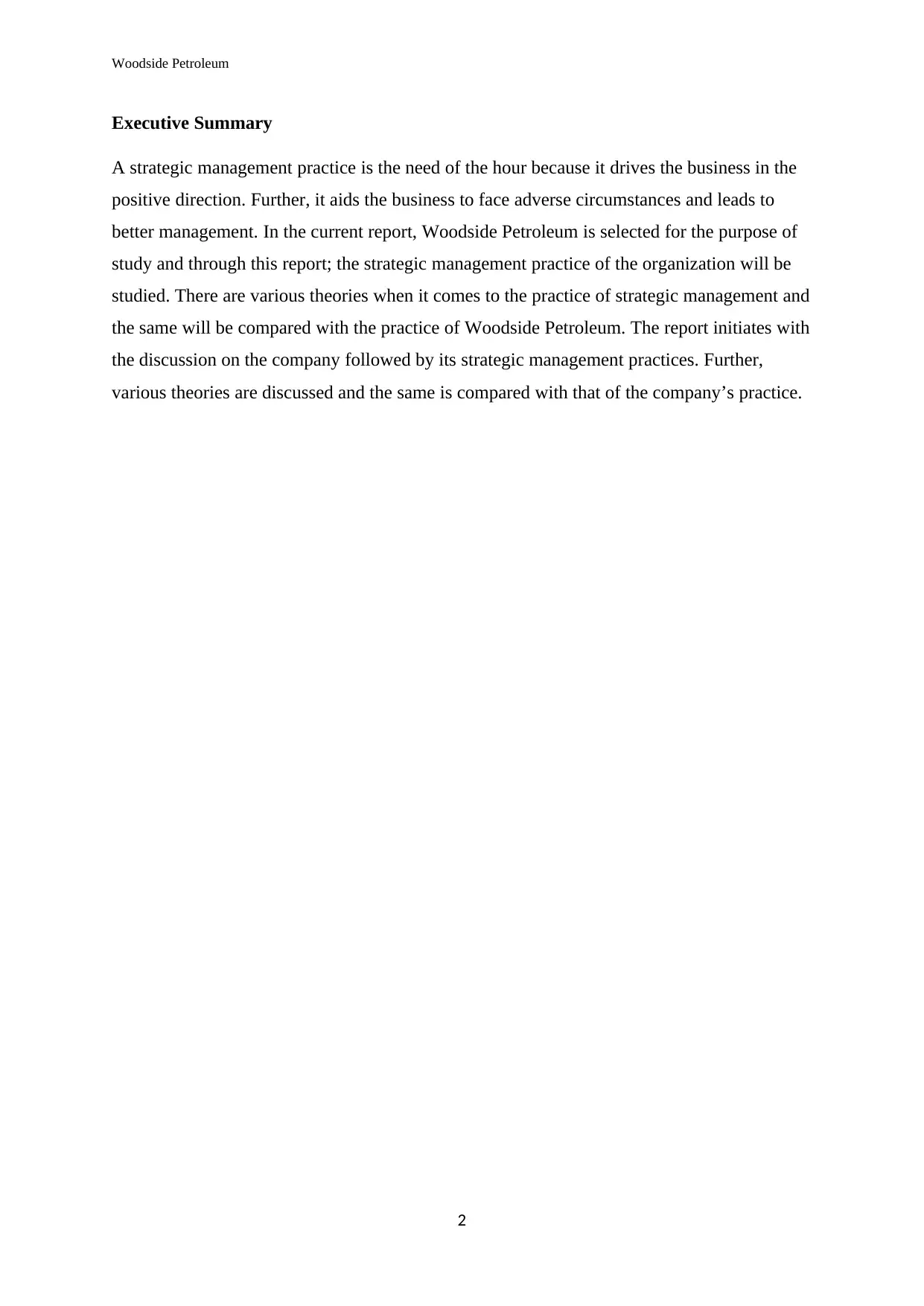
Woodside Petroleum
Executive Summary
A strategic management practice is the need of the hour because it drives the business in the
positive direction. Further, it aids the business to face adverse circumstances and leads to
better management. In the current report, Woodside Petroleum is selected for the purpose of
study and through this report; the strategic management practice of the organization will be
studied. There are various theories when it comes to the practice of strategic management and
the same will be compared with the practice of Woodside Petroleum. The report initiates with
the discussion on the company followed by its strategic management practices. Further,
various theories are discussed and the same is compared with that of the company’s practice.
2
Executive Summary
A strategic management practice is the need of the hour because it drives the business in the
positive direction. Further, it aids the business to face adverse circumstances and leads to
better management. In the current report, Woodside Petroleum is selected for the purpose of
study and through this report; the strategic management practice of the organization will be
studied. There are various theories when it comes to the practice of strategic management and
the same will be compared with the practice of Woodside Petroleum. The report initiates with
the discussion on the company followed by its strategic management practices. Further,
various theories are discussed and the same is compared with that of the company’s practice.
2
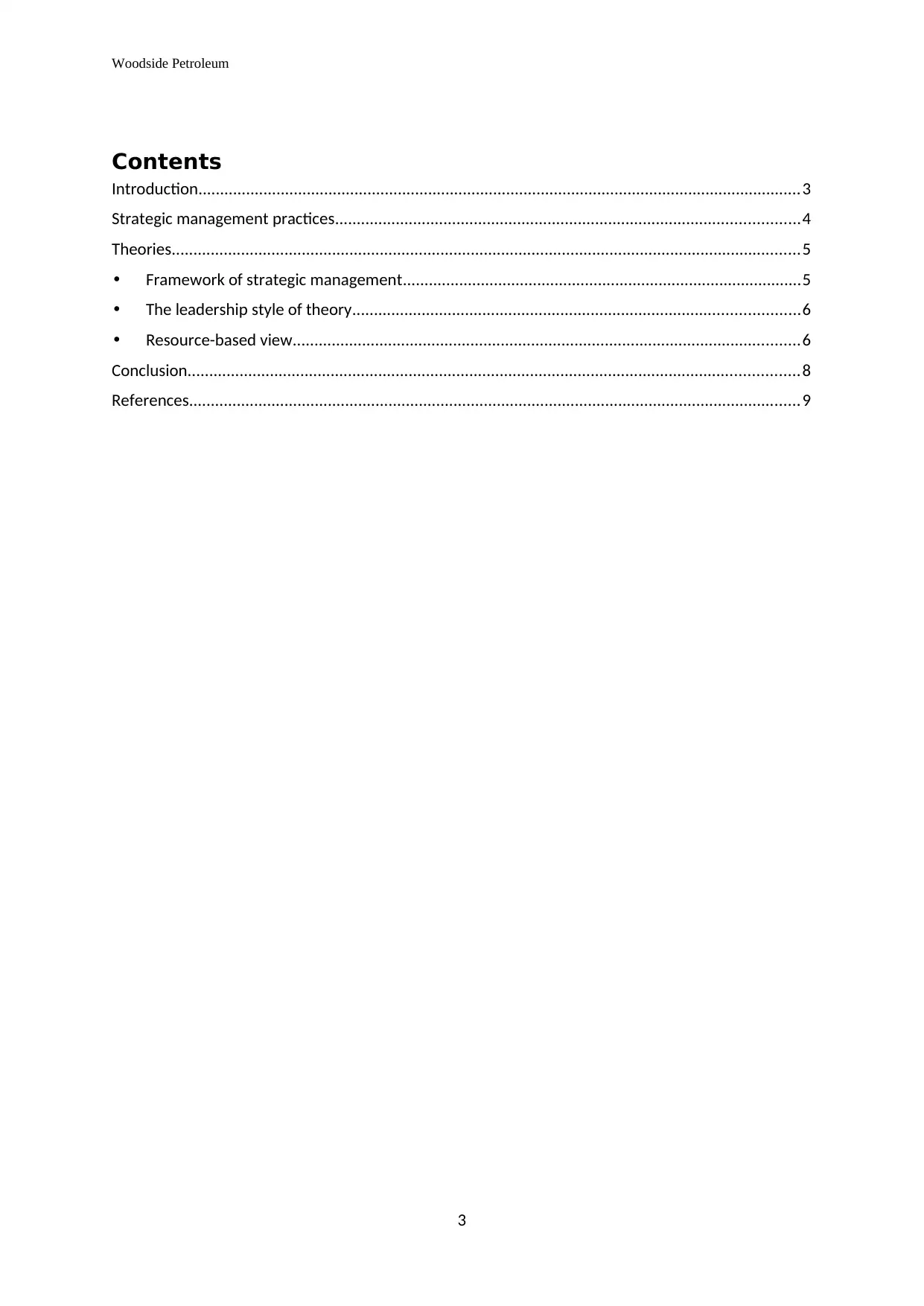
Woodside Petroleum
Contents
Introduction...........................................................................................................................................3
Strategic management practices...........................................................................................................4
Theories.................................................................................................................................................5
• Framework of strategic management............................................................................................5
• The leadership style of theory.......................................................................................................6
• Resource-based view.....................................................................................................................6
Conclusion.............................................................................................................................................8
References.............................................................................................................................................9
3
Contents
Introduction...........................................................................................................................................3
Strategic management practices...........................................................................................................4
Theories.................................................................................................................................................5
• Framework of strategic management............................................................................................5
• The leadership style of theory.......................................................................................................6
• Resource-based view.....................................................................................................................6
Conclusion.............................................................................................................................................8
References.............................................................................................................................................9
3
⊘ This is a preview!⊘
Do you want full access?
Subscribe today to unlock all pages.

Trusted by 1+ million students worldwide
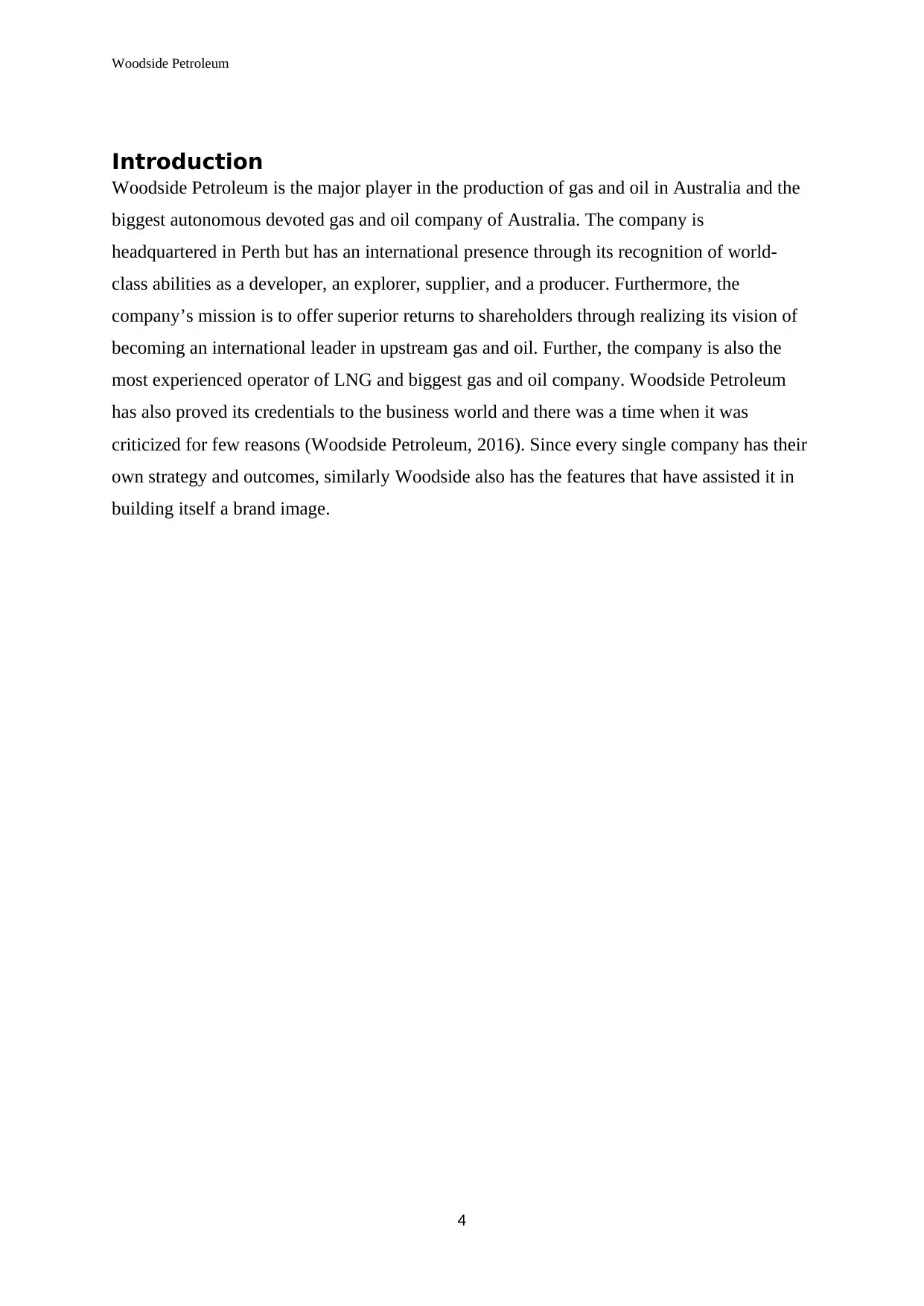
Woodside Petroleum
Introduction
Woodside Petroleum is the major player in the production of gas and oil in Australia and the
biggest autonomous devoted gas and oil company of Australia. The company is
headquartered in Perth but has an international presence through its recognition of world-
class abilities as a developer, an explorer, supplier, and a producer. Furthermore, the
company’s mission is to offer superior returns to shareholders through realizing its vision of
becoming an international leader in upstream gas and oil. Further, the company is also the
most experienced operator of LNG and biggest gas and oil company. Woodside Petroleum
has also proved its credentials to the business world and there was a time when it was
criticized for few reasons (Woodside Petroleum, 2016). Since every single company has their
own strategy and outcomes, similarly Woodside also has the features that have assisted it in
building itself a brand image.
4
Introduction
Woodside Petroleum is the major player in the production of gas and oil in Australia and the
biggest autonomous devoted gas and oil company of Australia. The company is
headquartered in Perth but has an international presence through its recognition of world-
class abilities as a developer, an explorer, supplier, and a producer. Furthermore, the
company’s mission is to offer superior returns to shareholders through realizing its vision of
becoming an international leader in upstream gas and oil. Further, the company is also the
most experienced operator of LNG and biggest gas and oil company. Woodside Petroleum
has also proved its credentials to the business world and there was a time when it was
criticized for few reasons (Woodside Petroleum, 2016). Since every single company has their
own strategy and outcomes, similarly Woodside also has the features that have assisted it in
building itself a brand image.
4
Paraphrase This Document
Need a fresh take? Get an instant paraphrase of this document with our AI Paraphraser
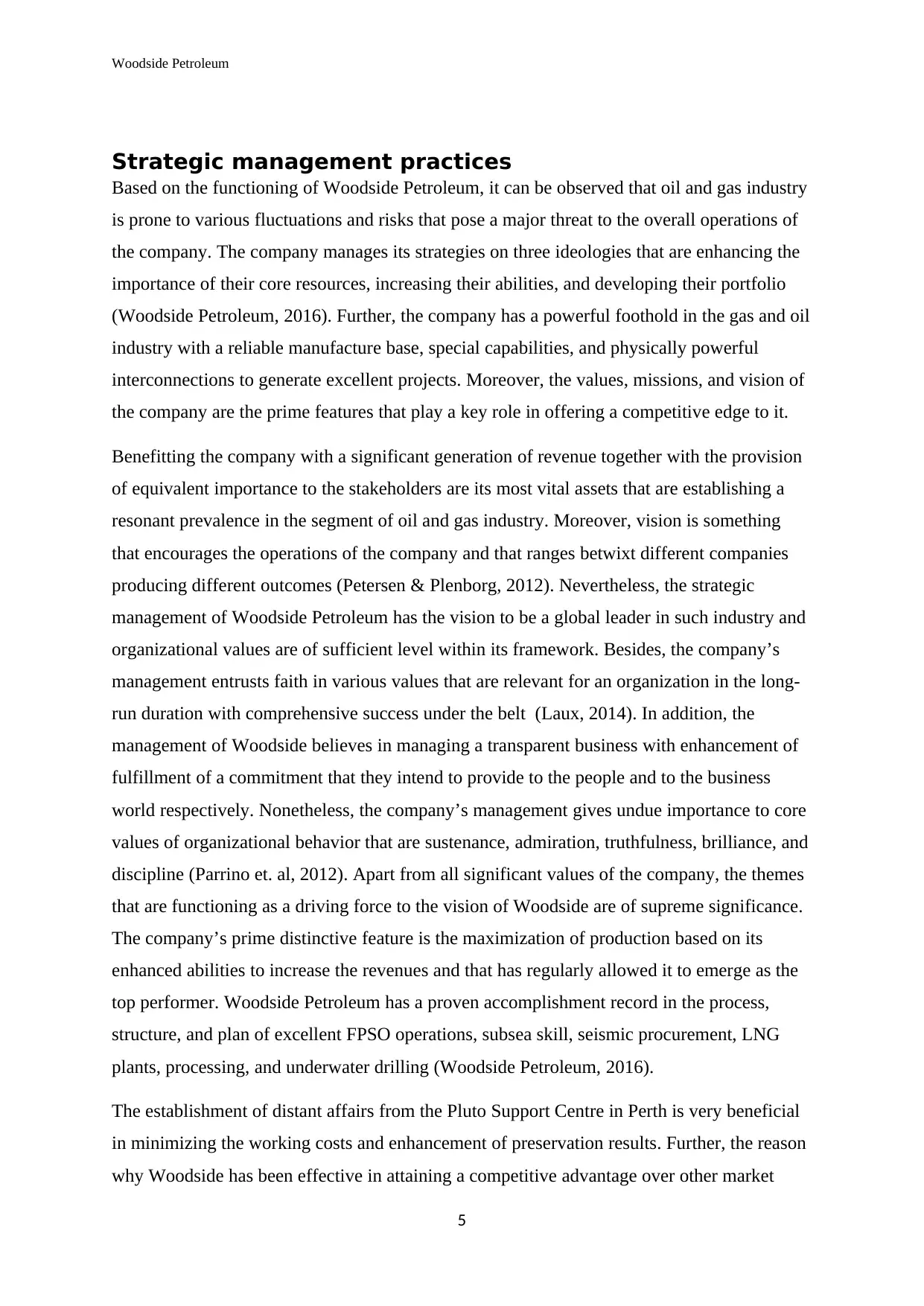
Woodside Petroleum
Strategic management practices
Based on the functioning of Woodside Petroleum, it can be observed that oil and gas industry
is prone to various fluctuations and risks that pose a major threat to the overall operations of
the company. The company manages its strategies on three ideologies that are enhancing the
importance of their core resources, increasing their abilities, and developing their portfolio
(Woodside Petroleum, 2016). Further, the company has a powerful foothold in the gas and oil
industry with a reliable manufacture base, special capabilities, and physically powerful
interconnections to generate excellent projects. Moreover, the values, missions, and vision of
the company are the prime features that play a key role in offering a competitive edge to it.
Benefitting the company with a significant generation of revenue together with the provision
of equivalent importance to the stakeholders are its most vital assets that are establishing a
resonant prevalence in the segment of oil and gas industry. Moreover, vision is something
that encourages the operations of the company and that ranges betwixt different companies
producing different outcomes (Petersen & Plenborg, 2012). Nevertheless, the strategic
management of Woodside Petroleum has the vision to be a global leader in such industry and
organizational values are of sufficient level within its framework. Besides, the company’s
management entrusts faith in various values that are relevant for an organization in the long-
run duration with comprehensive success under the belt (Laux, 2014). In addition, the
management of Woodside believes in managing a transparent business with enhancement of
fulfillment of a commitment that they intend to provide to the people and to the business
world respectively. Nonetheless, the company’s management gives undue importance to core
values of organizational behavior that are sustenance, admiration, truthfulness, brilliance, and
discipline (Parrino et. al, 2012). Apart from all significant values of the company, the themes
that are functioning as a driving force to the vision of Woodside are of supreme significance.
The company’s prime distinctive feature is the maximization of production based on its
enhanced abilities to increase the revenues and that has regularly allowed it to emerge as the
top performer. Woodside Petroleum has a proven accomplishment record in the process,
structure, and plan of excellent FPSO operations, subsea skill, seismic procurement, LNG
plants, processing, and underwater drilling (Woodside Petroleum, 2016).
The establishment of distant affairs from the Pluto Support Centre in Perth is very beneficial
in minimizing the working costs and enhancement of preservation results. Further, the reason
why Woodside has been effective in attaining a competitive advantage over other market
5
Strategic management practices
Based on the functioning of Woodside Petroleum, it can be observed that oil and gas industry
is prone to various fluctuations and risks that pose a major threat to the overall operations of
the company. The company manages its strategies on three ideologies that are enhancing the
importance of their core resources, increasing their abilities, and developing their portfolio
(Woodside Petroleum, 2016). Further, the company has a powerful foothold in the gas and oil
industry with a reliable manufacture base, special capabilities, and physically powerful
interconnections to generate excellent projects. Moreover, the values, missions, and vision of
the company are the prime features that play a key role in offering a competitive edge to it.
Benefitting the company with a significant generation of revenue together with the provision
of equivalent importance to the stakeholders are its most vital assets that are establishing a
resonant prevalence in the segment of oil and gas industry. Moreover, vision is something
that encourages the operations of the company and that ranges betwixt different companies
producing different outcomes (Petersen & Plenborg, 2012). Nevertheless, the strategic
management of Woodside Petroleum has the vision to be a global leader in such industry and
organizational values are of sufficient level within its framework. Besides, the company’s
management entrusts faith in various values that are relevant for an organization in the long-
run duration with comprehensive success under the belt (Laux, 2014). In addition, the
management of Woodside believes in managing a transparent business with enhancement of
fulfillment of a commitment that they intend to provide to the people and to the business
world respectively. Nonetheless, the company’s management gives undue importance to core
values of organizational behavior that are sustenance, admiration, truthfulness, brilliance, and
discipline (Parrino et. al, 2012). Apart from all significant values of the company, the themes
that are functioning as a driving force to the vision of Woodside are of supreme significance.
The company’s prime distinctive feature is the maximization of production based on its
enhanced abilities to increase the revenues and that has regularly allowed it to emerge as the
top performer. Woodside Petroleum has a proven accomplishment record in the process,
structure, and plan of excellent FPSO operations, subsea skill, seismic procurement, LNG
plants, processing, and underwater drilling (Woodside Petroleum, 2016).
The establishment of distant affairs from the Pluto Support Centre in Perth is very beneficial
in minimizing the working costs and enhancement of preservation results. Further, the reason
why Woodside has been effective in attaining a competitive advantage over other market
5
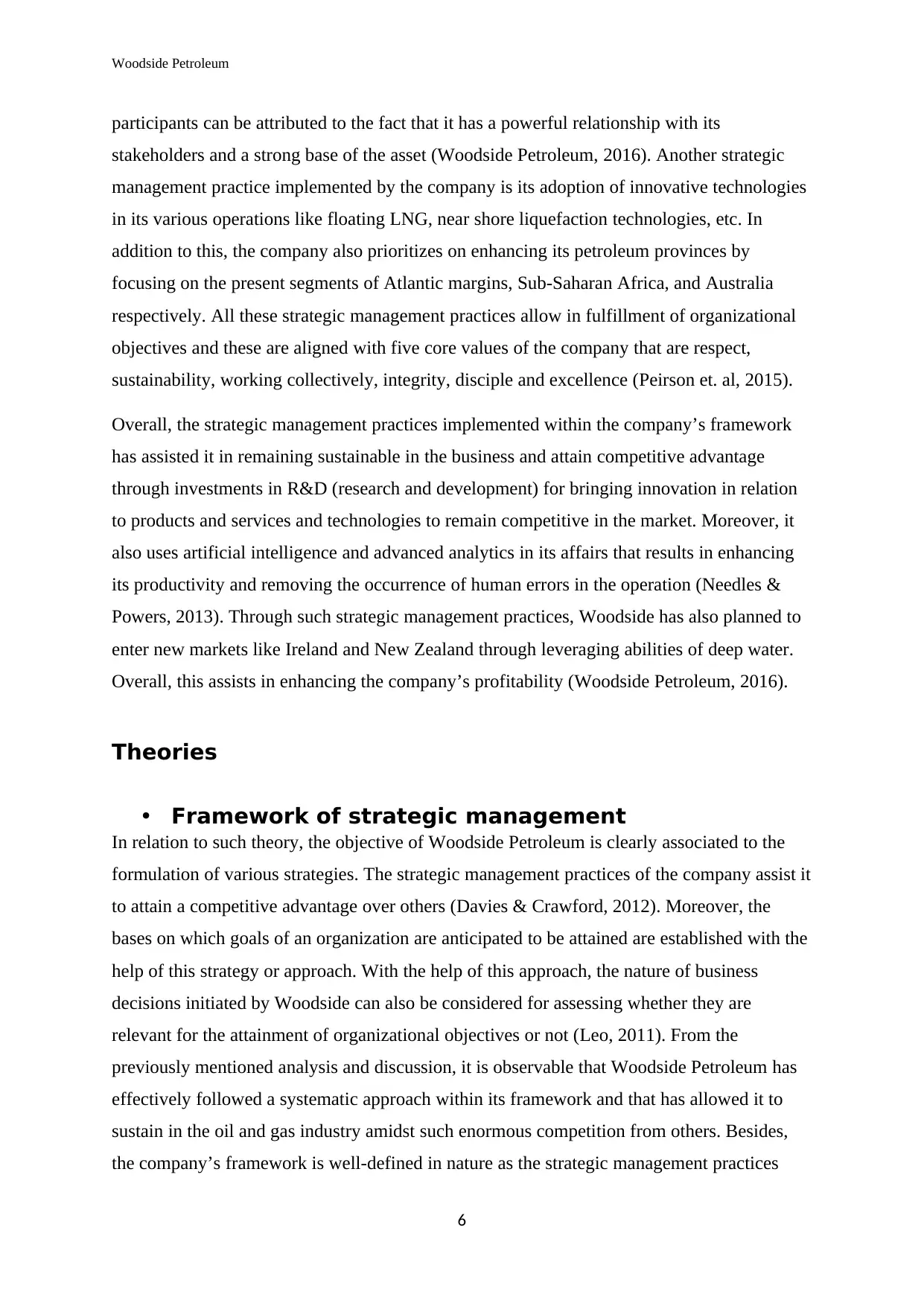
Woodside Petroleum
participants can be attributed to the fact that it has a powerful relationship with its
stakeholders and a strong base of the asset (Woodside Petroleum, 2016). Another strategic
management practice implemented by the company is its adoption of innovative technologies
in its various operations like floating LNG, near shore liquefaction technologies, etc. In
addition to this, the company also prioritizes on enhancing its petroleum provinces by
focusing on the present segments of Atlantic margins, Sub-Saharan Africa, and Australia
respectively. All these strategic management practices allow in fulfillment of organizational
objectives and these are aligned with five core values of the company that are respect,
sustainability, working collectively, integrity, disciple and excellence (Peirson et. al, 2015).
Overall, the strategic management practices implemented within the company’s framework
has assisted it in remaining sustainable in the business and attain competitive advantage
through investments in R&D (research and development) for bringing innovation in relation
to products and services and technologies to remain competitive in the market. Moreover, it
also uses artificial intelligence and advanced analytics in its affairs that results in enhancing
its productivity and removing the occurrence of human errors in the operation (Needles &
Powers, 2013). Through such strategic management practices, Woodside has also planned to
enter new markets like Ireland and New Zealand through leveraging abilities of deep water.
Overall, this assists in enhancing the company’s profitability (Woodside Petroleum, 2016).
Theories
• Framework of strategic management
In relation to such theory, the objective of Woodside Petroleum is clearly associated to the
formulation of various strategies. The strategic management practices of the company assist it
to attain a competitive advantage over others (Davies & Crawford, 2012). Moreover, the
bases on which goals of an organization are anticipated to be attained are established with the
help of this strategy or approach. With the help of this approach, the nature of business
decisions initiated by Woodside can also be considered for assessing whether they are
relevant for the attainment of organizational objectives or not (Leo, 2011). From the
previously mentioned analysis and discussion, it is observable that Woodside Petroleum has
effectively followed a systematic approach within its framework and that has allowed it to
sustain in the oil and gas industry amidst such enormous competition from others. Besides,
the company’s framework is well-defined in nature as the strategic management practices
6
participants can be attributed to the fact that it has a powerful relationship with its
stakeholders and a strong base of the asset (Woodside Petroleum, 2016). Another strategic
management practice implemented by the company is its adoption of innovative technologies
in its various operations like floating LNG, near shore liquefaction technologies, etc. In
addition to this, the company also prioritizes on enhancing its petroleum provinces by
focusing on the present segments of Atlantic margins, Sub-Saharan Africa, and Australia
respectively. All these strategic management practices allow in fulfillment of organizational
objectives and these are aligned with five core values of the company that are respect,
sustainability, working collectively, integrity, disciple and excellence (Peirson et. al, 2015).
Overall, the strategic management practices implemented within the company’s framework
has assisted it in remaining sustainable in the business and attain competitive advantage
through investments in R&D (research and development) for bringing innovation in relation
to products and services and technologies to remain competitive in the market. Moreover, it
also uses artificial intelligence and advanced analytics in its affairs that results in enhancing
its productivity and removing the occurrence of human errors in the operation (Needles &
Powers, 2013). Through such strategic management practices, Woodside has also planned to
enter new markets like Ireland and New Zealand through leveraging abilities of deep water.
Overall, this assists in enhancing the company’s profitability (Woodside Petroleum, 2016).
Theories
• Framework of strategic management
In relation to such theory, the objective of Woodside Petroleum is clearly associated to the
formulation of various strategies. The strategic management practices of the company assist it
to attain a competitive advantage over others (Davies & Crawford, 2012). Moreover, the
bases on which goals of an organization are anticipated to be attained are established with the
help of this strategy or approach. With the help of this approach, the nature of business
decisions initiated by Woodside can also be considered for assessing whether they are
relevant for the attainment of organizational objectives or not (Leo, 2011). From the
previously mentioned analysis and discussion, it is observable that Woodside Petroleum has
effectively followed a systematic approach within its framework and that has allowed it to
sustain in the oil and gas industry amidst such enormous competition from others. Besides,
the company’s framework is well-defined in nature as the strategic management practices
6
⊘ This is a preview!⊘
Do you want full access?
Subscribe today to unlock all pages.

Trusted by 1+ million students worldwide
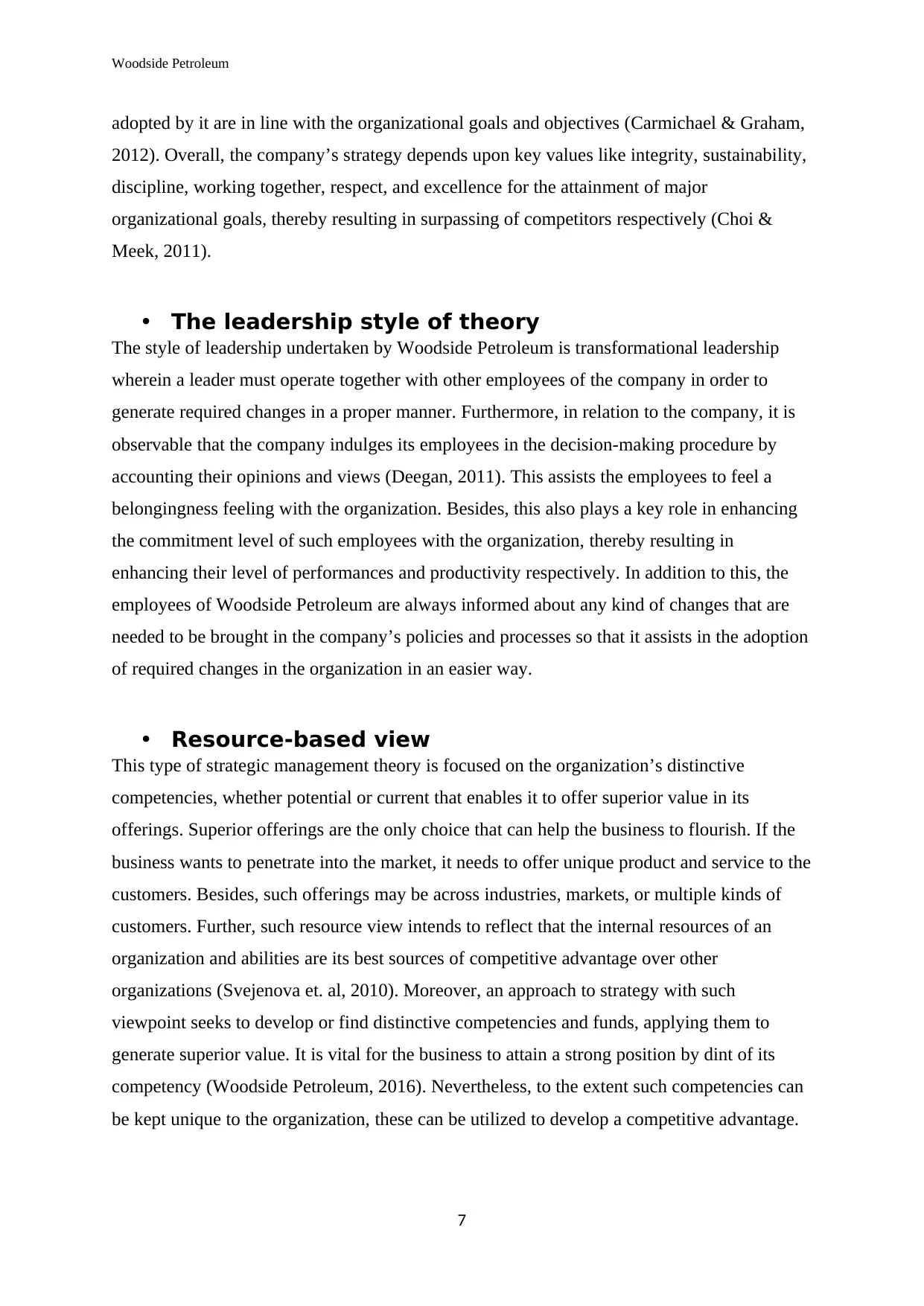
Woodside Petroleum
adopted by it are in line with the organizational goals and objectives (Carmichael & Graham,
2012). Overall, the company’s strategy depends upon key values like integrity, sustainability,
discipline, working together, respect, and excellence for the attainment of major
organizational goals, thereby resulting in surpassing of competitors respectively (Choi &
Meek, 2011).
• The leadership style of theory
The style of leadership undertaken by Woodside Petroleum is transformational leadership
wherein a leader must operate together with other employees of the company in order to
generate required changes in a proper manner. Furthermore, in relation to the company, it is
observable that the company indulges its employees in the decision-making procedure by
accounting their opinions and views (Deegan, 2011). This assists the employees to feel a
belongingness feeling with the organization. Besides, this also plays a key role in enhancing
the commitment level of such employees with the organization, thereby resulting in
enhancing their level of performances and productivity respectively. In addition to this, the
employees of Woodside Petroleum are always informed about any kind of changes that are
needed to be brought in the company’s policies and processes so that it assists in the adoption
of required changes in the organization in an easier way.
• Resource-based view
This type of strategic management theory is focused on the organization’s distinctive
competencies, whether potential or current that enables it to offer superior value in its
offerings. Superior offerings are the only choice that can help the business to flourish. If the
business wants to penetrate into the market, it needs to offer unique product and service to the
customers. Besides, such offerings may be across industries, markets, or multiple kinds of
customers. Further, such resource view intends to reflect that the internal resources of an
organization and abilities are its best sources of competitive advantage over other
organizations (Svejenova et. al, 2010). Moreover, an approach to strategy with such
viewpoint seeks to develop or find distinctive competencies and funds, applying them to
generate superior value. It is vital for the business to attain a strong position by dint of its
competency (Woodside Petroleum, 2016). Nevertheless, to the extent such competencies can
be kept unique to the organization, these can be utilized to develop a competitive advantage.
7
adopted by it are in line with the organizational goals and objectives (Carmichael & Graham,
2012). Overall, the company’s strategy depends upon key values like integrity, sustainability,
discipline, working together, respect, and excellence for the attainment of major
organizational goals, thereby resulting in surpassing of competitors respectively (Choi &
Meek, 2011).
• The leadership style of theory
The style of leadership undertaken by Woodside Petroleum is transformational leadership
wherein a leader must operate together with other employees of the company in order to
generate required changes in a proper manner. Furthermore, in relation to the company, it is
observable that the company indulges its employees in the decision-making procedure by
accounting their opinions and views (Deegan, 2011). This assists the employees to feel a
belongingness feeling with the organization. Besides, this also plays a key role in enhancing
the commitment level of such employees with the organization, thereby resulting in
enhancing their level of performances and productivity respectively. In addition to this, the
employees of Woodside Petroleum are always informed about any kind of changes that are
needed to be brought in the company’s policies and processes so that it assists in the adoption
of required changes in the organization in an easier way.
• Resource-based view
This type of strategic management theory is focused on the organization’s distinctive
competencies, whether potential or current that enables it to offer superior value in its
offerings. Superior offerings are the only choice that can help the business to flourish. If the
business wants to penetrate into the market, it needs to offer unique product and service to the
customers. Besides, such offerings may be across industries, markets, or multiple kinds of
customers. Further, such resource view intends to reflect that the internal resources of an
organization and abilities are its best sources of competitive advantage over other
organizations (Svejenova et. al, 2010). Moreover, an approach to strategy with such
viewpoint seeks to develop or find distinctive competencies and funds, applying them to
generate superior value. It is vital for the business to attain a strong position by dint of its
competency (Woodside Petroleum, 2016). Nevertheless, to the extent such competencies can
be kept unique to the organization, these can be utilized to develop a competitive advantage.
7
Paraphrase This Document
Need a fresh take? Get an instant paraphrase of this document with our AI Paraphraser
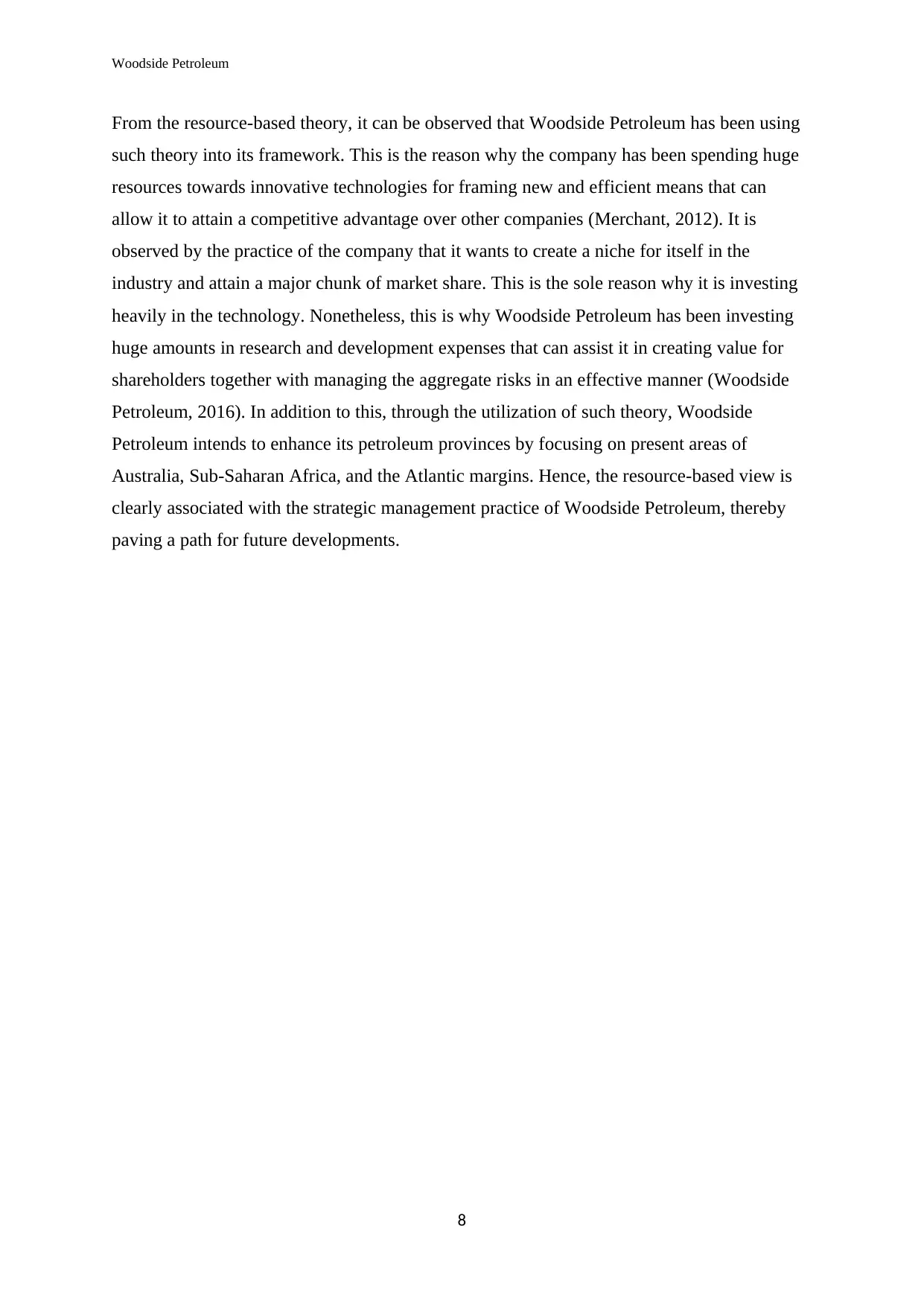
Woodside Petroleum
From the resource-based theory, it can be observed that Woodside Petroleum has been using
such theory into its framework. This is the reason why the company has been spending huge
resources towards innovative technologies for framing new and efficient means that can
allow it to attain a competitive advantage over other companies (Merchant, 2012). It is
observed by the practice of the company that it wants to create a niche for itself in the
industry and attain a major chunk of market share. This is the sole reason why it is investing
heavily in the technology. Nonetheless, this is why Woodside Petroleum has been investing
huge amounts in research and development expenses that can assist it in creating value for
shareholders together with managing the aggregate risks in an effective manner (Woodside
Petroleum, 2016). In addition to this, through the utilization of such theory, Woodside
Petroleum intends to enhance its petroleum provinces by focusing on present areas of
Australia, Sub-Saharan Africa, and the Atlantic margins. Hence, the resource-based view is
clearly associated with the strategic management practice of Woodside Petroleum, thereby
paving a path for future developments.
8
From the resource-based theory, it can be observed that Woodside Petroleum has been using
such theory into its framework. This is the reason why the company has been spending huge
resources towards innovative technologies for framing new and efficient means that can
allow it to attain a competitive advantage over other companies (Merchant, 2012). It is
observed by the practice of the company that it wants to create a niche for itself in the
industry and attain a major chunk of market share. This is the sole reason why it is investing
heavily in the technology. Nonetheless, this is why Woodside Petroleum has been investing
huge amounts in research and development expenses that can assist it in creating value for
shareholders together with managing the aggregate risks in an effective manner (Woodside
Petroleum, 2016). In addition to this, through the utilization of such theory, Woodside
Petroleum intends to enhance its petroleum provinces by focusing on present areas of
Australia, Sub-Saharan Africa, and the Atlantic margins. Hence, the resource-based view is
clearly associated with the strategic management practice of Woodside Petroleum, thereby
paving a path for future developments.
8
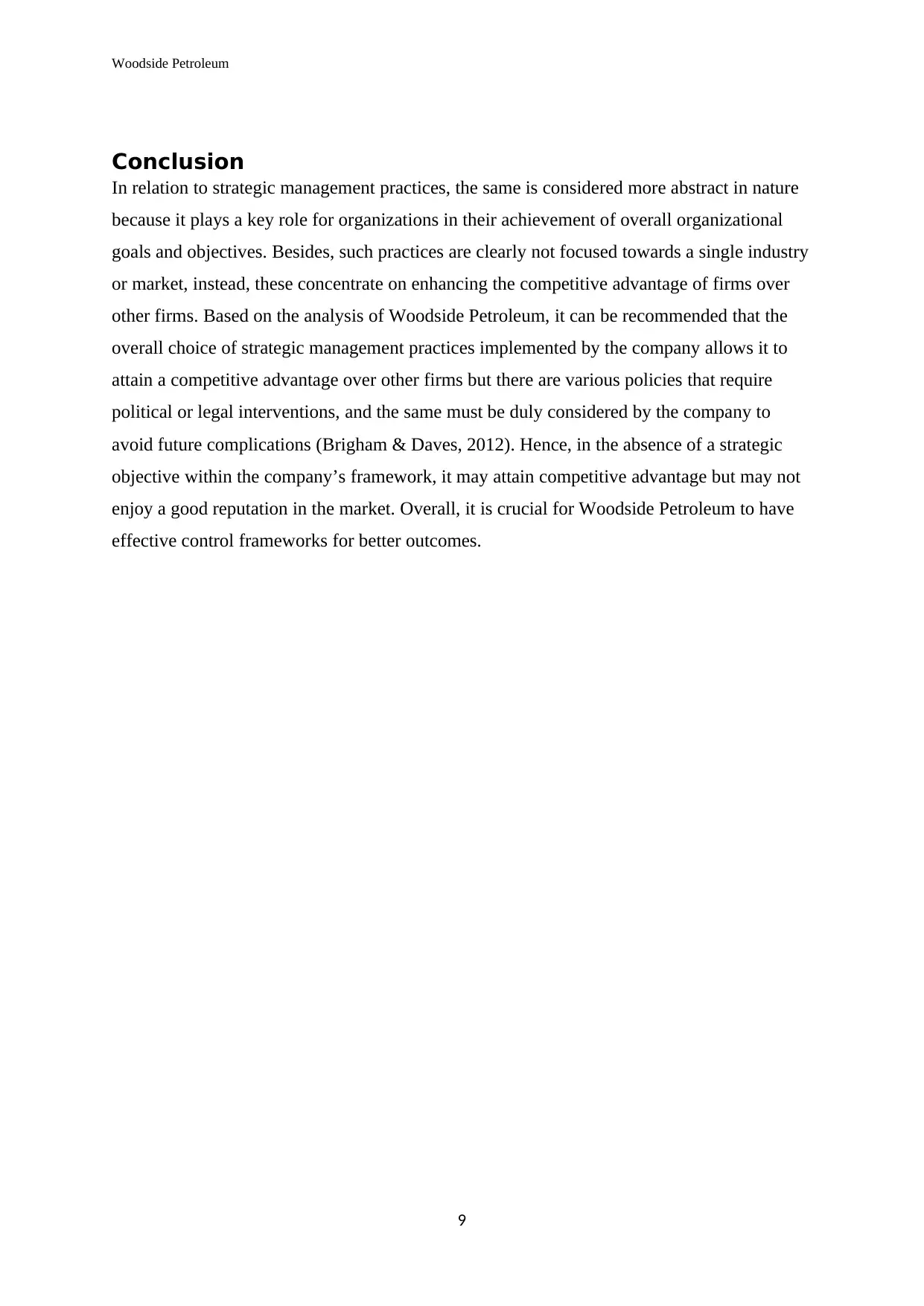
Woodside Petroleum
Conclusion
In relation to strategic management practices, the same is considered more abstract in nature
because it plays a key role for organizations in their achievement of overall organizational
goals and objectives. Besides, such practices are clearly not focused towards a single industry
or market, instead, these concentrate on enhancing the competitive advantage of firms over
other firms. Based on the analysis of Woodside Petroleum, it can be recommended that the
overall choice of strategic management practices implemented by the company allows it to
attain a competitive advantage over other firms but there are various policies that require
political or legal interventions, and the same must be duly considered by the company to
avoid future complications (Brigham & Daves, 2012). Hence, in the absence of a strategic
objective within the company’s framework, it may attain competitive advantage but may not
enjoy a good reputation in the market. Overall, it is crucial for Woodside Petroleum to have
effective control frameworks for better outcomes.
9
Conclusion
In relation to strategic management practices, the same is considered more abstract in nature
because it plays a key role for organizations in their achievement of overall organizational
goals and objectives. Besides, such practices are clearly not focused towards a single industry
or market, instead, these concentrate on enhancing the competitive advantage of firms over
other firms. Based on the analysis of Woodside Petroleum, it can be recommended that the
overall choice of strategic management practices implemented by the company allows it to
attain a competitive advantage over other firms but there are various policies that require
political or legal interventions, and the same must be duly considered by the company to
avoid future complications (Brigham & Daves, 2012). Hence, in the absence of a strategic
objective within the company’s framework, it may attain competitive advantage but may not
enjoy a good reputation in the market. Overall, it is crucial for Woodside Petroleum to have
effective control frameworks for better outcomes.
9
⊘ This is a preview!⊘
Do you want full access?
Subscribe today to unlock all pages.

Trusted by 1+ million students worldwide
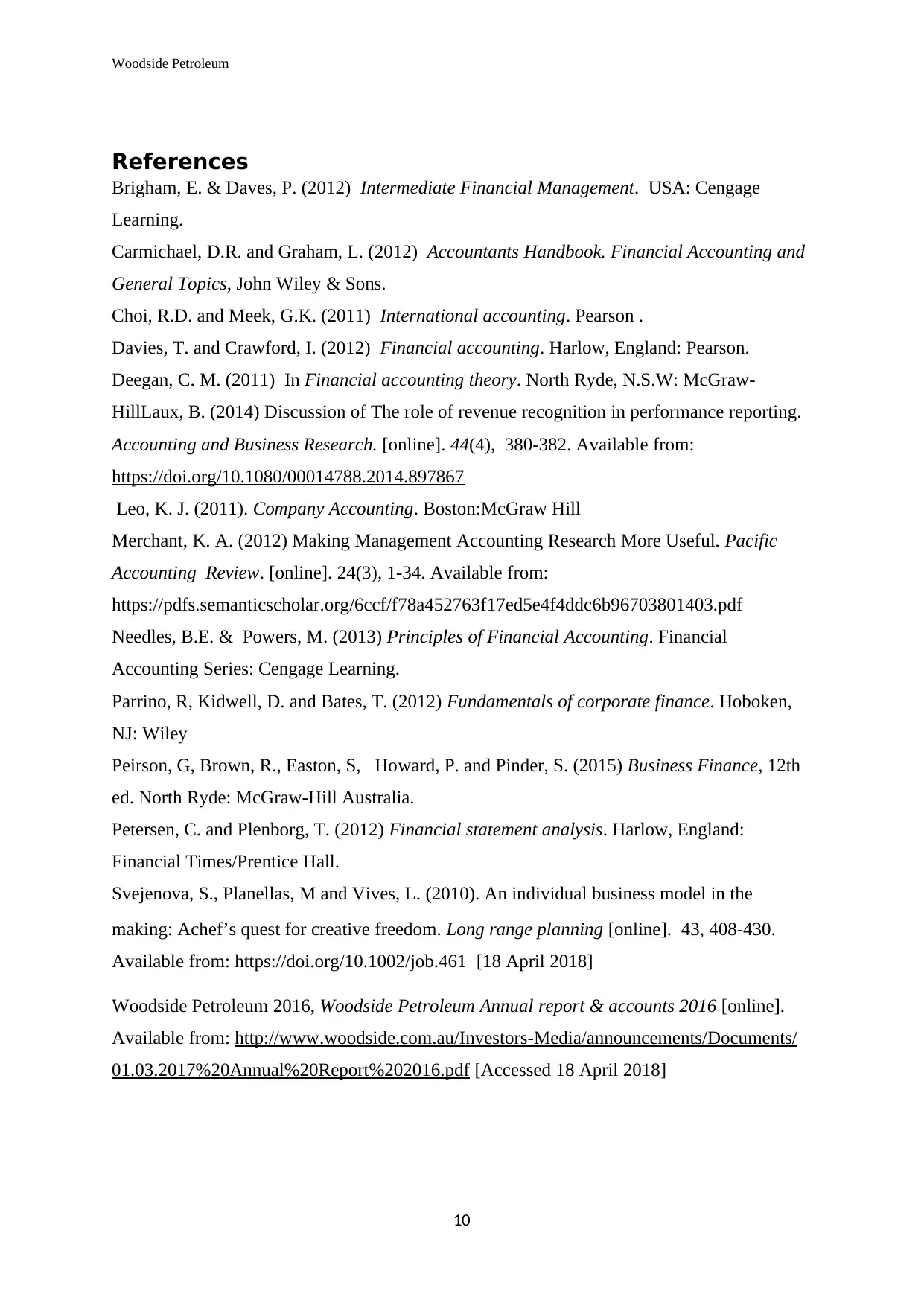
Woodside Petroleum
References
Brigham, E. & Daves, P. (2012) Intermediate Financial Management. USA: Cengage
Learning.
Carmichael, D.R. and Graham, L. (2012) Accountants Handbook. Financial Accounting and
General Topics, John Wiley & Sons.
Choi, R.D. and Meek, G.K. (2011) International accounting. Pearson .
Davies, T. and Crawford, I. (2012) Financial accounting. Harlow, England: Pearson.
Deegan, C. M. (2011) In Financial accounting theory. North Ryde, N.S.W: McGraw-
HillLaux, B. (2014) Discussion of The role of revenue recognition in performance reporting.
Accounting and Business Research. [online]. 44(4), 380-382. Available from:
https://doi.org/10.1080/00014788.2014.897867
Leo, K. J. (2011). Company Accounting. Boston:McGraw Hill
Merchant, K. A. (2012) Making Management Accounting Research More Useful. Pacific
Accounting Review. [online]. 24(3), 1-34. Available from:
https://pdfs.semanticscholar.org/6ccf/f78a452763f17ed5e4f4ddc6b96703801403.pdf
Needles, B.E. & Powers, M. (2013) Principles of Financial Accounting. Financial
Accounting Series: Cengage Learning.
Parrino, R, Kidwell, D. and Bates, T. (2012) Fundamentals of corporate finance. Hoboken,
NJ: Wiley
Peirson, G, Brown, R., Easton, S, Howard, P. and Pinder, S. (2015) Business Finance, 12th
ed. North Ryde: McGraw-Hill Australia.
Petersen, C. and Plenborg, T. (2012) Financial statement analysis. Harlow, England:
Financial Times/Prentice Hall.
Svejenova, S., Planellas, M and Vives, L. (2010). An individual business model in the
making: Achef’s quest for creative freedom. Long range planning [online]. 43, 408-430.
Available from: https://doi.org/10.1002/job.461 [18 April 2018]
Woodside Petroleum 2016, Woodside Petroleum Annual report & accounts 2016 [online].
Available from: http://www.woodside.com.au/Investors-Media/announcements/Documents/
01.03.2017%20Annual%20Report%202016.pdf [Accessed 18 April 2018]
10
References
Brigham, E. & Daves, P. (2012) Intermediate Financial Management. USA: Cengage
Learning.
Carmichael, D.R. and Graham, L. (2012) Accountants Handbook. Financial Accounting and
General Topics, John Wiley & Sons.
Choi, R.D. and Meek, G.K. (2011) International accounting. Pearson .
Davies, T. and Crawford, I. (2012) Financial accounting. Harlow, England: Pearson.
Deegan, C. M. (2011) In Financial accounting theory. North Ryde, N.S.W: McGraw-
HillLaux, B. (2014) Discussion of The role of revenue recognition in performance reporting.
Accounting and Business Research. [online]. 44(4), 380-382. Available from:
https://doi.org/10.1080/00014788.2014.897867
Leo, K. J. (2011). Company Accounting. Boston:McGraw Hill
Merchant, K. A. (2012) Making Management Accounting Research More Useful. Pacific
Accounting Review. [online]. 24(3), 1-34. Available from:
https://pdfs.semanticscholar.org/6ccf/f78a452763f17ed5e4f4ddc6b96703801403.pdf
Needles, B.E. & Powers, M. (2013) Principles of Financial Accounting. Financial
Accounting Series: Cengage Learning.
Parrino, R, Kidwell, D. and Bates, T. (2012) Fundamentals of corporate finance. Hoboken,
NJ: Wiley
Peirson, G, Brown, R., Easton, S, Howard, P. and Pinder, S. (2015) Business Finance, 12th
ed. North Ryde: McGraw-Hill Australia.
Petersen, C. and Plenborg, T. (2012) Financial statement analysis. Harlow, England:
Financial Times/Prentice Hall.
Svejenova, S., Planellas, M and Vives, L. (2010). An individual business model in the
making: Achef’s quest for creative freedom. Long range planning [online]. 43, 408-430.
Available from: https://doi.org/10.1002/job.461 [18 April 2018]
Woodside Petroleum 2016, Woodside Petroleum Annual report & accounts 2016 [online].
Available from: http://www.woodside.com.au/Investors-Media/announcements/Documents/
01.03.2017%20Annual%20Report%202016.pdf [Accessed 18 April 2018]
10
1 out of 10
Related Documents
Your All-in-One AI-Powered Toolkit for Academic Success.
+13062052269
info@desklib.com
Available 24*7 on WhatsApp / Email
![[object Object]](/_next/static/media/star-bottom.7253800d.svg)
Unlock your academic potential
Copyright © 2020–2025 A2Z Services. All Rights Reserved. Developed and managed by ZUCOL.




